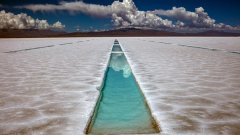
A greener and more equitable future — that's the idea behind a first-of-its-kind plant to be built in Kenya that could remove up to 1 million tons of carbon dioxide from the atmosphere every year.
The proposal to build a direct air capture plant, as a joint venture between Swiss company Climeworks and Kenya-based Great Carbon Valley, has been billed as a springboard for creating a new, green economy in Africa as the world is expected to in climate-related investment in the coming years.
sucks in carbon dioxide from the atmosphere and , a process that is . The technology has been criticized by some climate scientists who argue that the technology is a dangerous distraction from the only viable solution to climate change: Cutting greenhouse gas emissions by transitioning en masse away from fossil fuels. Others say that direct air capture is to limit global warming.
"The world is going to need to decarbonize," said Bilha Ndirangu, CEO of Great Carbon Valley. "There will be different investments and innovations in decarbonization efforts. How do we make sure that some of those investments are happening in Africa?"
The case for investing in Africa is heightened by the disproportionate impacts of climate change, such as extreme drought and flooding, on African nations that have contributed little to the world's greenhouse gas emissions. Last month, discussions at and the Africa Climate Summit in Nairobi focused on how to attract more capital to the continent — the world's youngest continent, with under the age of 30.
Calls for investment in Africa are tempered by watchdogs who say foreign investment in the global South can be harmful if investors from the global North prioritize profit over the safety and rights of local populations.
"There's a real need for safeguards on where these projects are taking place," said Ugbaad Kosar, the director of environmental justice at Carbon180, a climate nonprofit that advocates for equitable carbon removal. "And once that's decided, it's important to track how the resources, benefits and risks are being distributed among the companies and vulnerable populations."
More from NBC News:
Carbon removal companies such as Climeworks create carbon credits corresponding to units of carbon dioxide captured by their plants — these credits can be purchased by companies to offset their carbon emissions. With carbon removal, companies that continue to use fossil fuels can claim to be carbon-neutral because they purchased offsets created by plants like the one planned for Kenya.
"All direct air capture does is help fossil fuel companies pretend they're taking climate action while they continue to drill for oil," Jonathan Foley, a climate scientist and founder of Project Drawdown, a nonprofit climate group, said. "Trading a few seconds of the world's greenhouse gas emissions to give oil and gas companies a fig leaf is not a good bargain."
The plant, projected to be completed by 2028, will be built in the Great Rift Valley, an intercontinental depression rich in deep basalt formations that extends across Kenya from Tanzania and onward to Ethiopia.
Ndirangu said that the project is an opportunity for Kenya to tackle the climate crisis while creating jobs and expanding the renewable energy grid.
Kenya has a relatively small energy grid that relies mostly on renewable energy. The country is rich in geothermal, solar and wind potential — but that renewable energy potential is untapped, said Carlijn Nouwen, co-founder of the nonprofit Climate Action Platform for Africa.
Many energy companies see little incentive to invest in Kenya's energy infrastructure, but the energy-intensive Climeworks project could help attract investment in the grid and in turn benefit Kenyan citizens, Nouwen said — though she cautioned that Kenyan policymakers would need to enact policies to ensure the new energy reaches citizens.
Olúfẹ́mi O. Táíwò, a professor of philosophy specializing in climate justice at Georgetown University, said he was skeptical that the project would benefit Kenyans over protecting the companies' bottom lines.
"The investment coming in is to set up carbon removal that allows corporations in rich countries to dump their carbon pollution in the global South," Táíwò said. "That's not the kind of investment that inspires confidence in our progress on climate justice."
Whether the technology is helpful or harmful, most experts agree that direct air capture is limited by massive price tags, heavy energy requirements and lack of scalability. Globally, 27 direct air capture plants remove — a tiny fraction of the pumped into the atmosphere by human activities in 2022.
Some say investing in direct air capture technology is pointless.
"We don't have an infinite amount of renewable energy," said Mark Jacobson, a professor of environmental engineering at Stanford University. "If it's being used for direct air capture, it's not being used for something else. And right now, all our renewable energy is needed to replace fossil fuels."
Julie Gosalvez, chief marketing officer of Climeworks, said judging the potential of a technology based on its current efficiency is not right, adding that the company plans to bring their net carbon removal into the billions of metric tons over the next few decades.
Gosalvez added that about 90% of the climate solution is cutting carbon emissions by transitioning from fossil fuels, but emphasized that some carbon removal is needed.
Many global climate leaders agree. the Intergovernmental Panel on Climate Change stated that all pathways to keeping global warming below 1.5 C include carbon dioxide removal.




